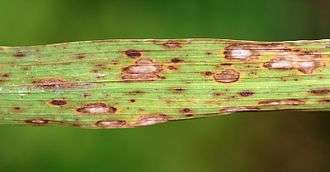Cochliobolus miyabeanus
| Cochliobolus miyabeanus | |
|---|---|
 | |
| Symptoms of Cochliobolus miyabeanus on rice | |
| Scientific classification | |
| Kingdom: | Fungi |
| Division: | Ascomycota |
| Class: | Dothideomycetes |
| Order: | Pleosporales |
| Family: | Pleosporaceae |
| Genus: | Cochliobolus |
| Species: | C. miyabeanus |
| Binomial name | |
| Cochliobolus miyabeanus | |
Cochliobolus miyabeanus (formerly known as Helminthosporium oryzae) is a fungus that causes brown spot disease in rice. This disease was the causal agent of the Bengal famine of 1943.
It was used by the USA as a biological weapon in Japan during World War II.[1]
Hosts and symptoms
Brown spot of rice is a plant fungal disease that usually occurs on the host leaves and glume, as well as seedlings, sheaths, stems and grains of adult host plants. Hosts include Oryza (Asian rice), Leersia (Cutgrass), Zizania (Wild rice), and other species as well such as Echinochloa colona (junglerice) and Zea mays (maize).[2][3]
Cochliobolus miyabeanus may cause a wide range of symptoms. General symptoms occurring on the hosts can be observed on many parts of the plant, including leaves, seeds, stems and inflorescences, along with the presence of brown spot. Discoloration of stems is another symptom develops from brown spot of rice disease. Oval-shaped brown spots are the fungal growth sign, which have grey colored center developed on host leaves.
Also, lesions on glumes and seeds occur if the pathogen associates with other fungi and insects. Such lesions may develop when favorable condition for sporulation is present.
Importance
Cochliobolus miyabeanus is an important plant pathogen because it causes a common and widespread rice disease that causes high level of crop yield losses. It was a major cause of the Bengal famine of 1943, where the crop yield was dropped by 40% to 90% and death of 2 million people was recorded.[3] It is a possible agroterrorism weapon.[4] It was used as biological anti-crop weapon that aimed to attack staple crops of specific places. United States treated this pathogen as a biological weapon when attacking Japan during the Second World War; Cochliobolus miyabeanus was used as the biological anti-crop agent that attacked staple foods in Japan, which was rice. Other known severe crop loss cases caused by Cochliobolus miyabeanus are globally distributed.[3] In the Philippines, rice seedling mortality rate records up to 60%. In India and Nigeria, it can reduce total crop yield by up to 40%. Similar losses are observed in Suriname and Sumatra.
Environment
There are several factors influencing the disease cycle and epidemics of brown spot of rice disease.[5]
1. Rainfall and drought [5] - The first factor affecting Cochliobolus miyabeanus life cycle is rainfall and drought. It tends to proliferate when there is reduced rainfall and in dewy conditions. In addition to low level of precipitation, severe epidemic of rice brown spot occurs during drought season. Compared to well flooded or irrigated area, the disease occurrence was favored in drier environment where reduced amount of water was present.
2. Temperature and humidity - Another factor affecting disease development for Cochliobolus miyabeanus is temperature and humidity. Infection efficiency is influenced by humidity level of the leaves, and lowered minimum temperature for crop cultivation favors its epidemics. Cochliobolus miyabeanus grows well at lower temperatures during its developmental stages compared to the grown up stage,[6] so if high temperature is maintained in the area it is likely that the farmers can restrict growth of the pathogen. The optimal temperature for the pathogen is 28 degree Celsius.[7]
3. Nutrition level[5] - Nutrition of the host plant may also influence level of disease development. For example, soil fertility is associated with the epidemics of rice brown spot. If soil minerals such as nitrogen, potassium, phosphorus, silicon and manganese are deficient, it is likely that the disease development is favored. In specific, in areas where silicon is present in high amount in the soil, the host becomes less susceptible to the disease because silicon not only alleviates physiological stresses of the host, but also generates disease resistance ability to the host. Furthermore, soil moisture level contributes to disease occurrence. Brown spot of rice is favored in areas where water level is low in soil.
See also
References
- ↑ Suffert, Frédéric; Émilie Latxague; Ivan Sache (11 March 2009). "Plant pathogens as agroterrorist weapons: assessment of the threat for European agriculture and forestry". Food Security. Springer Netherlands. 1 (2): 221–232. doi:10.1007/s12571-009-0014-2. Retrieved 14 May 2009.
- ↑ "Cochliobolus miyabeanus (Japanese Fungi on Plants)".
- 1 2 3 "Brown leaf spot of rice (Cochliobolus miyabeanus)".
- ↑ Suffert, Frédéric; Latxague, Émilie; Sache, Ivan (2009-03-11). "Plant pathogens as agroterrorist weapons: assessment of the threat for European agriculture and forestry". Food Security. 1 (2): 221–232. doi:10.1007/s12571-009-0014-2.
- 1 2 3 Barnwal, M. K.; Kotasthane, A.; Magculia, N.; Mukherjee, P. K.; Savary, S.; Sharma, A. K.; Singh, H. B.; Singh, U. S.; Sparks, A. H. (2013-03-10). "A review on crop losses, epidemiology and disease management of rice brown spot to identify research priorities and knowledge gaps". European Journal of Plant Pathology. 136 (3): 443–457. doi:10.1007/s10658-013-0195-6. ISSN 0929-1873.
- ↑ Moore, David. Fungal Morphogenesis. p. 186.
- ↑ Ou, Shu Huang. Rice Diseases. p. 207.
Sources
- World Food Crisis: Meeting the demands of a growing population by Jeff Batten, APS/CPS Annual Meeting, Monday, August 9, 1999